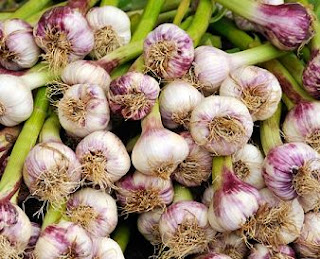Garlic is a commonly consumed foods. Garlic contains an energy of 95 kilocalories, protein 4.5 g, carbohydrates 23.1 grams, 0.2 grams fat, 42 milligrams of calcium, phosphorus 134 milligrams and 1 milligram of iron. Also in Garlic is also contained as much as 0 IU of vitamin A, vitamin B1 and vitamin C 0.22 milligrams 15 milligrams. The results obtained from conducted a study of 100 grams of Garlic, the number of which can be eaten as much as 88%.
Detailed information content of nutrients In 100 gr Garlic:
- Part Garlic can be consumed (BDD / Food Edible) = 88%
- Amount of Energy Ingredients Garlic = 95 kcal
- Protein content of Garlic amount = 4.5 g
- Garlic amount of fat content = 0.2 gr
- Number of Carbohydrate Content of Garlic = 23.1 g
- The content of Calcium Garlic number = 42 mg
- Phosphorus content Garlic number = 134 mg
- Number Garlic Iron content = 1 mg
- The content of Vitamin A number Garlic = 0 IU
- The content of Vitamin B1 amount Garlic = 0.22 mg
- The amount of Vitamin C content of Garlic = 15 mg
Many tests have shown that garlic contains an antibacterial and antifungal agent. Garlic can also maintain the immune system, which in the case of HIV is needed. Garlic is proven to be effective against a number of opportunistic infections (OIs), including herpes viruses, cytomegalovirus, cryptosporidiosis (crypto), and mycobacterial organisms or candida. In some cases, Western medicine is not effective for treating this condition. Garlic contains sulfur, amino acids, minerals including germanium, selenium, and zinc, and vitamins A, B, and C. Allicin is believed to be a substance content of garlic are most beneficial, in addition to producing the pungent odor.
What Side Effects of Garlic?
Garlic cause fewer side effects, but high doses can cause upset stomach or bowel disorders. This is especially true when used raw garlic. Additionally, the smell can be regarded as less unpleasant side effects! Garlic reduces the blood's ability to clot. Therefore, should not be used by people who experience thrombocytopenia (deficiency of the element in the blood that freezing it).
Is Garlic Interact With Other Drugs?
Garlic and supplements that contain garlic or allicin can reduce the levels of saquinavir (a protease inhibitor) in the blood of an average of 51%. This is probably very influential on saquinavir activity against HIV, with the possibility of HIV becomes resistant to the drug. Although it has not been studied, the possibility of this interaction occurs on other protease inhibitors and NNRTIs. The clear implication is that doctors and patients should be cautious when using garlic or garlic supplements contain along with ART. Because garlic reduces the blood's ability to clot, should be avoided by people taking antiplatelet drugs or antifreeze (eg, warfarin). Because aspirin can also delay blood clotting, should the use of excessive garlic together with aspirin should be avoided.






